Integrating Driving Hardware-in-the-Loop Simulator with Large-Scale VANET Simulator for Evaluation of Cooperative Eco-Driving System
Abstract
1. Introduction
2. Background
2.1. Integrated Simulator for Evaluation of C-ITS
2.2. Hardware-in-the-Loop Simulation
3. Integrated Driving HIL Simulator for Evaluation of Cooperative Eco-Driving System
3.1. dSPACE Simulator Mid-Size
3.2. dSPACE MicroAutoBox
3.3. QualNet
3.4. Cohda Wireless MK5
3.5. Interaction between Simulators
4. Evaluation
4.1. Cooperative Eco-Driving Speed Guidance Application
4.2. Setup
4.3. Results
5. Conclusions
Author Contributions
Funding
Conflicts of Interest
References
- Beloufa, S.; Cauchard, F.; Vedrenne, J.; Vailleau, B.; Kemeny, A.; Mérienne, F.; Boucheix, J.M. Learning eco-driving behaviour in a driving simulator: Contribution of instructional videos and interactive guidance system. Transp. Res. Part F Traffic Psychol. Behav. 2019, 61, 201–216. [Google Scholar] [CrossRef]
- Hu, J.; Shao, Y.; Sun, Z.; Wang, M.; Bared, J.; Huang, P. Integrated optimal eco-driving on rolling terrain for hybrid electric vehicle with vehicle-infrastructure communication. Transp. Res. Part C Emerg. Technol. 2016, 68, 228–244. [Google Scholar] [CrossRef]
- Zambrano-Martinez, J.L.; Calafate, C.T.; Soler, D.; Lemus-Zúñiga, L.-G.; Cano, J.-C.; Manzoni, P.; Gayraud, T. A centralized route-management solution for autonomous vehicles in urban areas. Electronics 2019, 8, 722. [Google Scholar] [CrossRef]
- Hallerbach, S.; Xia, Y.; Eberle, U.; Koester, F. Simulation-based identification of critical scenarios for cooperative and automated vehicles. SAE Intl. J. CAV 2018, 1, 93–106. [Google Scholar] [CrossRef]
- Mangharam, R.; Weller, D.; Rajkumar, R.; Mudalige, P.; Bai, F. Groovenet: A hybrid simulator for vehicle-to-vehicle networks. In Proceedings of the 2006 Third Annual International Conference on Mobile and Ubiquitous Systems: Networking & Services, San Jose, CA, USA, 17–21 July 2006; pp. 1–8. [Google Scholar]
- Balcioglu, B.X. Integrated V2V Wireless Network and Vehicular Traffic Simulator Design. Master’s Thesis, Science in the Graduate School of the Ohio State University, Columbus, OH, USA, 2009. [Google Scholar]
- Rondinone, M.; Maneros, J.; Krajzewicz, D.; Bauza, R.; Cataldi, P.; Hrizi, F.; Goza-lvez, J.; Kumar, V.; Röckl, M.; Lin, L.; et al. iTETRIS: A modular simulation platform for the large scale evaluation of cooperative its applications. Simul. Model. Pract. Theory 2013, 34, 99–125. [Google Scholar] [CrossRef]
- Schünemann, B. V2x simulation runtime infrastructure VSimRTI: An assessment tool to design smart traffic management systems. Comput. Netw. 2011, 55, 3189–3198. [Google Scholar] [CrossRef]
- Sommer, C.; German, R.; Dressler, F. Bidirectionally coupled network and road traffic simulation for improved IVC analysis. IEEE Trans. Mob. Comput. 2011, 10, 3–15. [Google Scholar] [CrossRef]
- Gajananan, K.; Sontisirikit, S.; Zhang, J.; Miska, M.; Chung, E.; Guha, S.; Prendinger, H. A cooperative ITS study on green light optimization using an integrated traffic, driving, and communication simulator. In Proceedings of the 36th-ATRF, Brisbane, Queensland, Australia, 2–4 October 2013; pp. 1–13. [Google Scholar]
- Prendinger, H.; Miska, M.; Gajananan, K.; Nantes, A. A cyber-physical system simulator for risk-free transport studies. Comput. Aided Civ. Infrastruct. Eng. 2014, 29, 480–495. [Google Scholar] [CrossRef]
- Zhao, Y.; Wagh, A.; Hou, Y.; Hulme, K.; Qiao, C. Integrated traffic driving- networking simulator for the design of connected vehicle applications: Eco-signal case study. J. Intell. Transp. Syst. 2016, 20, 75–87. [Google Scholar] [CrossRef]
- Aramrattana, M.; Larsson, T.; Jansson, J.; Nåbo, A. A simulation framework for cooperative intelligent transport systems testing and evaluation. Transp. Res. Part F Traffic Psychol. Behav. 2019, 61, 268–280. [Google Scholar] [CrossRef]
- Tibba, G.; Malz, C.; Stoermer, C.; Nagarajan, N.; Zhang, L.; Chakraborty, S. Testing automotive embedded systems under X-in-the-loop setups. In Proceedings of the 35th International Conference on Computer-Aided Design ICCAD 2016, New York, NY, USA, 7–10 November 2016. [Google Scholar]
- dSPACE, “dSPACE Simulator Mid-Size”. Available online: https://www.dspace.com/en/inc/home/products/hw/simulator_hardware/dspace_simulator_mid_size.cfm (accessed on 21 September 2020).
- dSPACE, “ModelDesk, MotionDesk, ControlDesk”. Available online: https://www.dspace.com/en/inc/home/products/products.cfm (accessed on 21 September 2020).
- Scalable Network Technologies, “QualNet (Quality Networking)”. Available online: https://www.scalable-networks.com/products/qualnet-network-simulation-software-tool/ (accessed on 21 September 2020).
- dSPACE, “MicroAutobox II”. Available online: https://www.dspace.com/en/inc/home/products/hw/micautob/microautobox2.cfm (accessed on 21 September 2020).
- Cohda Wireless, “MK5”. Available online: https://cohdawireless.com/solutions/hardware/mk5-obu/ (accessed on 21 September 2020).
- dSPACE, “Closed-Loop HIL Testing of V2X-Based Applications”. Available online: https://www.dspace.com/en/inc/home/applicationfields/our_solutions_for/driver_assistance_systems/hil_simulation/closed_loop_hil_system_v2x.cfm (accessed on 21 September 2020).
- Kamal, M.A.S.; Mukai, M.; Murata, J.; Kawabe, T. Ecological driver assistance system using model based anticipation of vehicle-road-traffic information. IET J. Intell. Transp. Syst. 2010, 4, 244–251. [Google Scholar] [CrossRef]
- Zhao, J.; Hu, Y.; Muldoon, S.; Chang, C.F. ‘InfoRich’ eco-driving control strategy for connected and automated vehicles. In Proceedings of the American Control Conference, Philadelphia, PA, USA, 10–12 July 2019; pp. 4621–4627. [Google Scholar]
- Cui, L.; Park, B. Assessing eco-driving behaviors using driving simulator. In Proceedings of the 96th Annual Meeting Transportation Research Board, Washington, DC, USA, 8–12 January 2017; pp. 1–16. [Google Scholar]
- Patil, K.; Molla, S.K.; Schulze, T. Hybrid vehicle model development using ASM-AMESim-Simscape co-simulation for real-time HIL applications. In Proceedings of the SAE 2012 World Congress & Exhibition, Detroit, MI, USA, 24–26 April 2012. [Google Scholar]
- Cantas, M.R.; Kavas, O.; Tamilarasan, S.; Gelbal, S.Y.; Guvenc, L. Use of hardware in the loop (HIL) simulation for developing connected autonomous vehicle (CAV) applications. In Proceedings of the WCX SAE World Congress Experience, Detroit, MI, USA, 13–15 April 2019. [Google Scholar]
- Ha, S.; Park, T.; Na, W.; Lee, H. Power distribution control algorithm for fuel economy optimization of 48V mild hybrid vehicle. In Proceedings of the International Conference on Modeling and Applied Simulation, Barcelona, Spain, 18–20 September 2017; pp. 185–190. [Google Scholar]
- De Ponte Muller, F. Survey on ranging sensors and cooperative techniques for relative positioning of vehicles. Sensors 2017, 17, 271. [Google Scholar] [CrossRef] [PubMed]
- Giordano, E.; Frank, R.; Pau, G.; Gerla, M. CORNER: A radio propagation model for VANETs in urban scenarios. Proc. IEEE 2011, 99, 1280–1294. [Google Scholar] [CrossRef]
- Beaulieu, N.C.; Cheng, C. Efficient Nakagami-m fading channel simulation. IEEE Trans. Veh. Technol. 2005, 54, 413–424. [Google Scholar] [CrossRef]
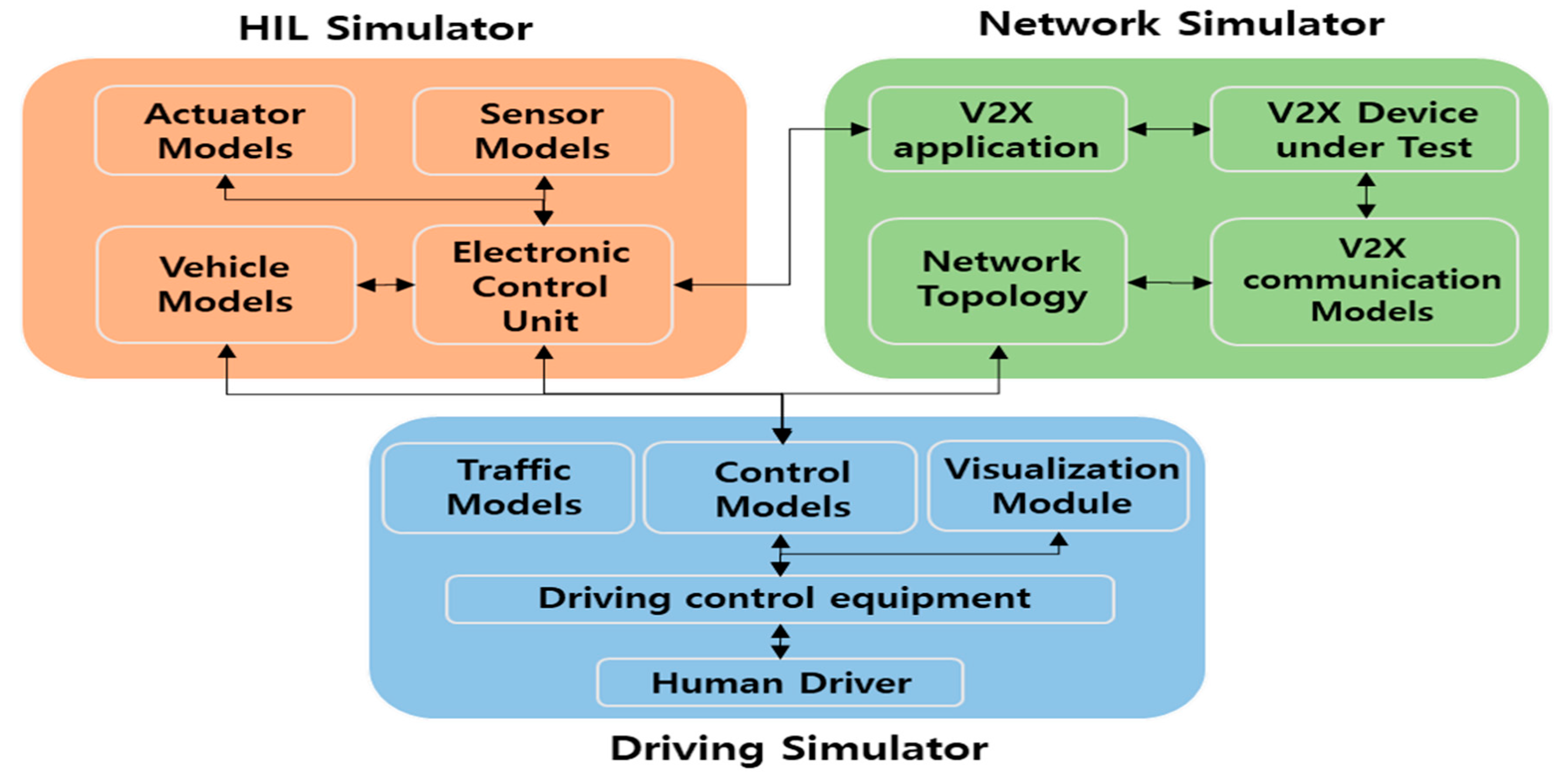
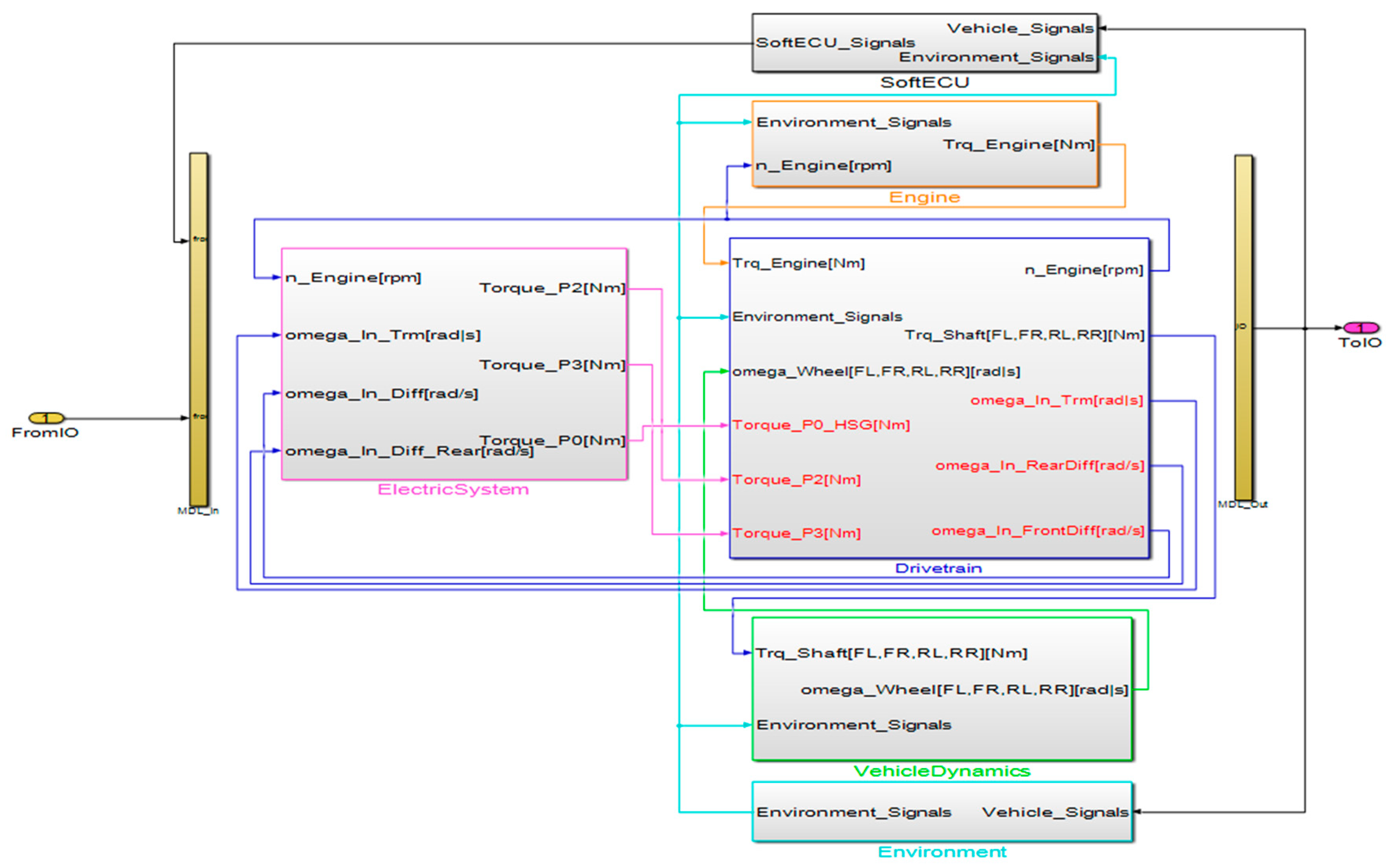
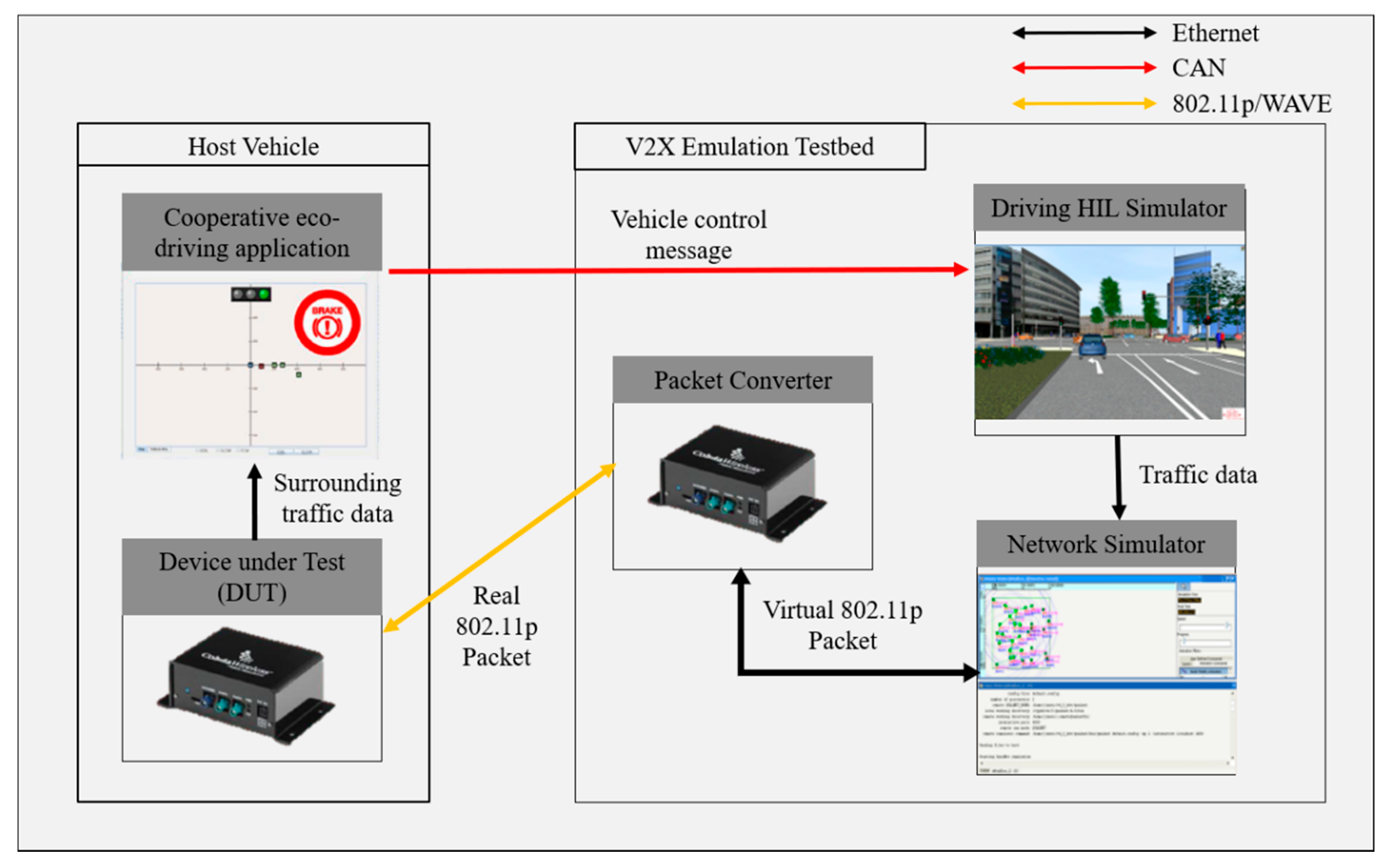




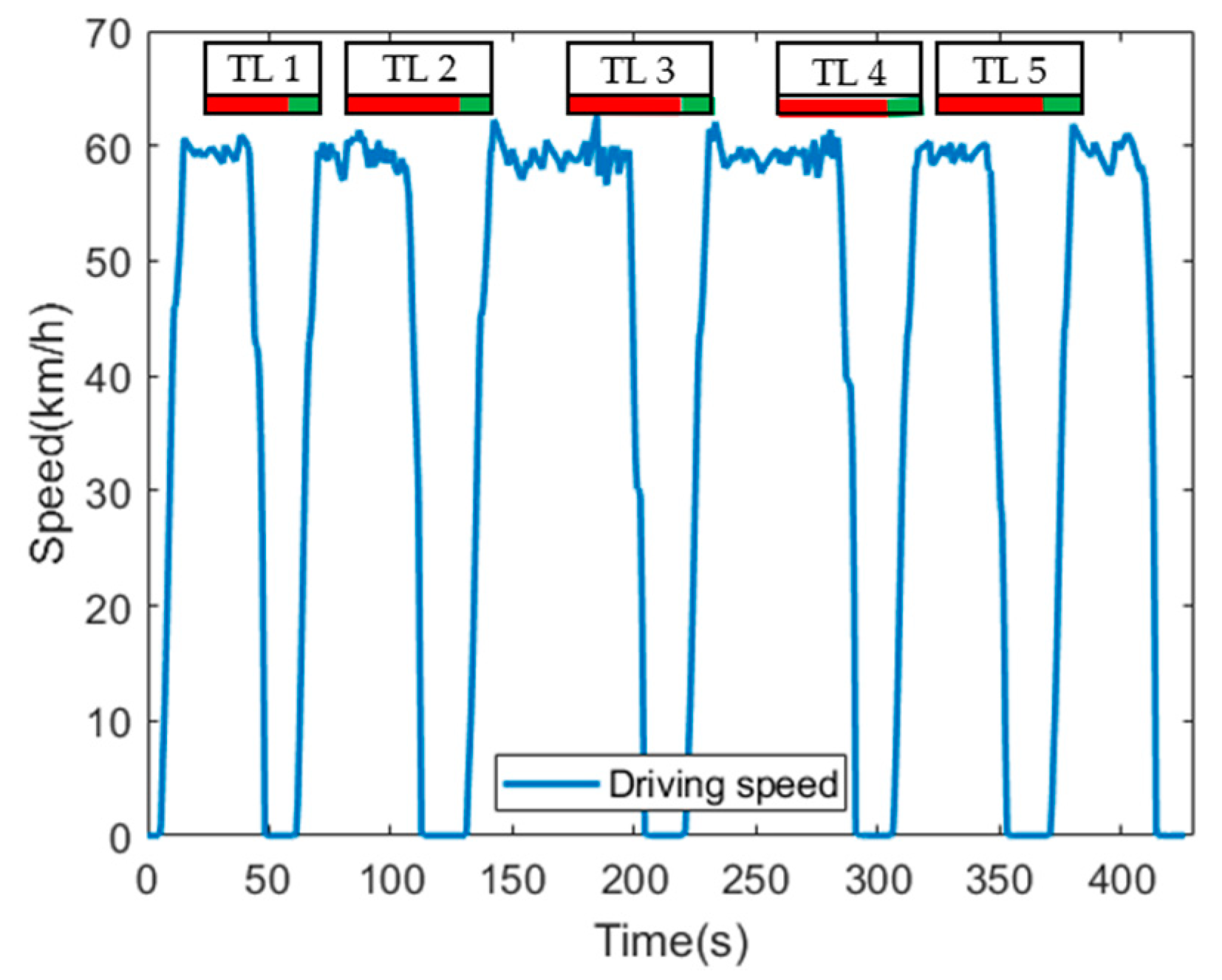



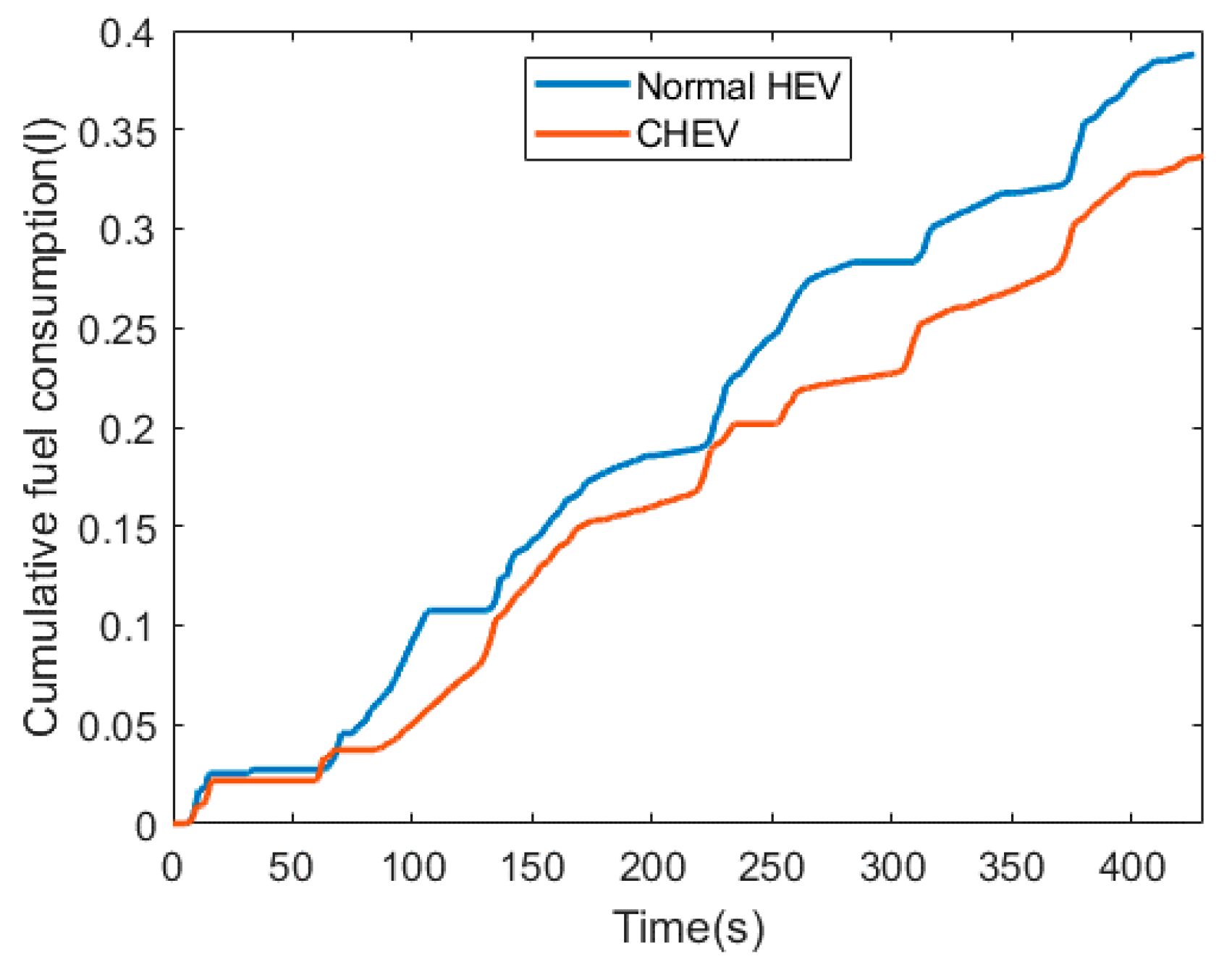
| Parameter | Value | |
|---|---|---|
| Total distance | 4.7 km | |
| Speed limit of road | 60 km/h | |
| Number of traffic light | 5 | |
| Data rate of DUT | 6 Mbps | |
| Transmission power of DUT | 26 dBm | |
| Communication range | 300 m | |
| Vehicle type | TMED-type HEV | |
| Vehicle weight | 1880 kg | |
| Engine | Displacement | 2900 cc |
| Maximum power | 185 kW | |
| Motor | Maximum power | 38 kW |
| Maximum torque | 205 Nm | |
| Maximum rpm | 6000 | |
| Battery | Rated voltage | 270 V |
| Rated capacity | 5.5 Ah | |
| Maximum power | 56 kW | |
| Type | Total Fuel (L) | Fuel Efficiency (km/L) | Improvement (%) |
|---|---|---|---|
| Normal HEV | 0.3855 | 12.34 | |
| CHEV | 0.3368 | 14.11 | 14.34 |
© 2020 by the authors. Licensee MDPI, Basel, Switzerland. This article is an open access article distributed under the terms and conditions of the Creative Commons Attribution (CC BY) license (http://creativecommons.org/licenses/by/4.0/).
Share and Cite
Lee, G.; Ha, S.; Jung, J.-i. Integrating Driving Hardware-in-the-Loop Simulator with Large-Scale VANET Simulator for Evaluation of Cooperative Eco-Driving System. Electronics 2020, 9, 1645. https://doi.org/10.3390/electronics9101645
Lee G, Ha S, Jung J-i. Integrating Driving Hardware-in-the-Loop Simulator with Large-Scale VANET Simulator for Evaluation of Cooperative Eco-Driving System. Electronics. 2020; 9(10):1645. https://doi.org/10.3390/electronics9101645
Chicago/Turabian StyleLee, Geonil, Seongmin Ha, and Jae-il Jung. 2020. "Integrating Driving Hardware-in-the-Loop Simulator with Large-Scale VANET Simulator for Evaluation of Cooperative Eco-Driving System" Electronics 9, no. 10: 1645. https://doi.org/10.3390/electronics9101645
APA StyleLee, G., Ha, S., & Jung, J.-i. (2020). Integrating Driving Hardware-in-the-Loop Simulator with Large-Scale VANET Simulator for Evaluation of Cooperative Eco-Driving System. Electronics, 9(10), 1645. https://doi.org/10.3390/electronics9101645





